The Importance Of Long-Tail Keywords In The Latest Google Search Update
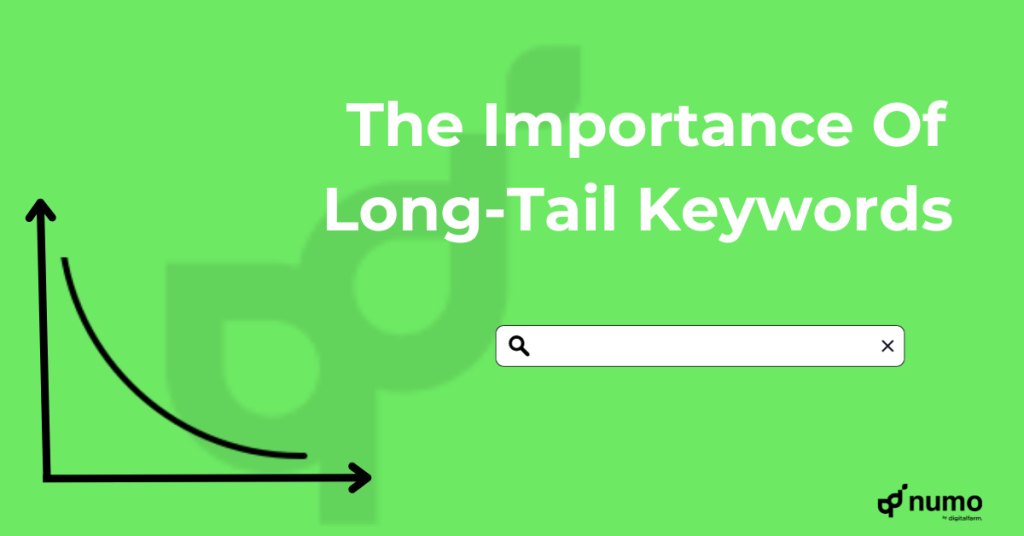
Google’s search algorithm is continuously changing to provide users with more relevant and personalized results. Google’s recent updates mainly focus on user intent and context. They aim to ensure a better user experience. This is where long-tail keywords come into play. The use of long-tail and more specific keywords plays a significant role in SEO. The importance of long-tail keywords continues to grow with each Google search algorithm update.
These longer, more detailed keyword phrases help content creators connect with what users are looking for and match their search intent. In this article, we’ll explore what long-tail keywords are all about, why they matter in Google’s latest search changes, and how you can use them to boost your online presence. Whether you’re an SEO enthusiast or a business owner looking to improve your online visibility, this article will guide you through the world of long-tail keywords, making SEO simpler and more effective for you.
What Are Long-Tail Keywords In Google Search?
Long-tail keywords are specific and detailed phrases that users type into the search bar when looking for particular information, products, or services. Long-tail keywords consist of three or more words. Generally, these long-tail keywords have low search volume. It has low competition and higher conversion rates.
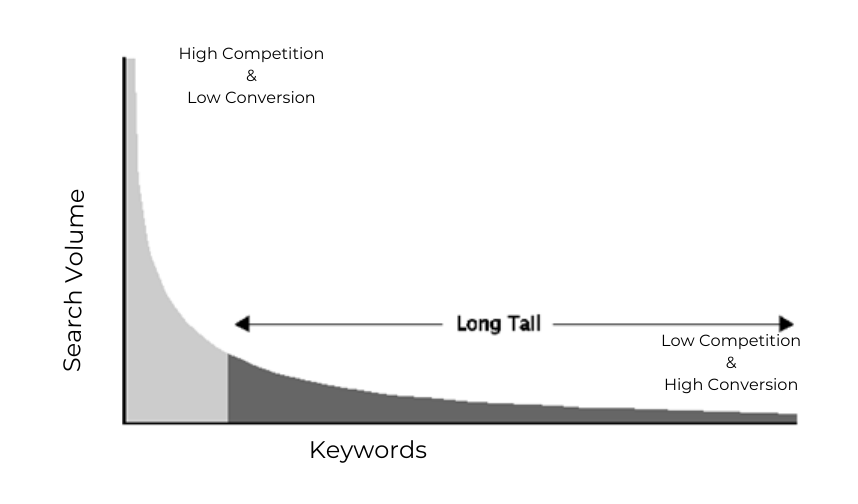
What is the importance of Long-tail Keywords?
The latest Google search update has brought several significant changes in how the search engine ranks and displays the search results.
Google’s latest updates like BERT and Helpful Content update, prioritizes content depth and expertise. By focusing on long-tail keywords, you can create in-depth content that can position your website as an authority in your niche.
Here’s why long-tail keywords have become an important point in this update:
Specific User Intent
Google’s latest algorithms have become more advanced in understanding user intent. Long-tail keywords are phrases or search queries that are typically longer. They are more specific than generic, short keywords. Unlike short keywords, long-tail keywords often provide additional context or specific details. These longer, more detailed phrases help Google to better understand the user intent behind the search query.
Here is the long-tail keyword example to understand this in a better way:
If you enter the short keyword “Digital Marketing”. These words can’t tell what exactly the user is looking for. Here users could be searching for various things such as a “local Digital Marketing agency ” or “Digital Marketing course” or “Digital Marketing jobs”.
However, if you search for “Digital Marketing agency in Abu Dhabi”, google will understand exactly what the user is looking for. Long-tail keywords like this help search engines understand user intentions more accurately.
Easy To Rank
Short keywords are very competitive and it takes a lot of time to rank.
Now let’s take our above example, “Digital Marketing” and check the keyword difficulty.
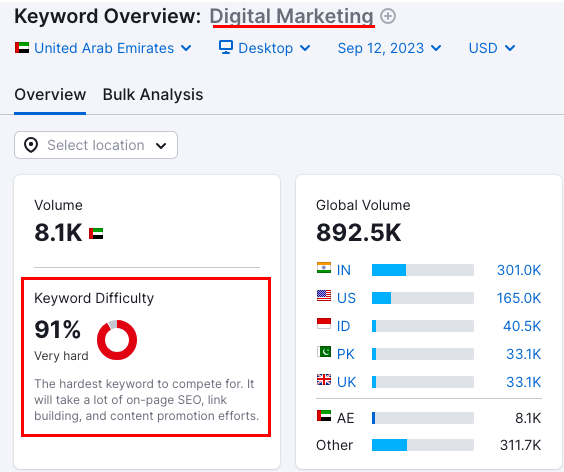
So here, the short keyword “Digital Marketing” has a keyword difficulty score of “91%”. This indicates that the keyword is very competitive and very hard to rank.
On the other hand, the long-tail keyword “Digital Marketing agency in Abu Dhabi” is comparatively less competitive. It has less keyword difficulty “40%” and is possible to rank.
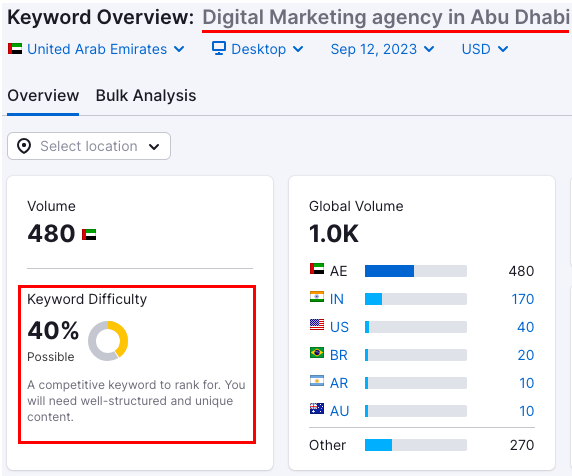
Content Depth and Authority
Long-tail keywords play an important role for a new website. Generally, new websites have very low authority. And it’s challenging to rank for high-competition keywords. However, you can use long-tail keywords, which consist of specific search phrases with lower competition. You can then create in-depth content for your target audience and gain visibility in search engine results pages. As a result, you can experience a gradual increase in organic traffic and overall authority.
Higher Conversion Rates
Usually, long-tail keywords are used by the user who is in the buying or making decision process. The user has a clear idea of what they want. This makes them more likely to convert into customers or take the desired action on the website.
For example, someone searching for “SEO services in Abu Dhabi” is showing a very specific intent. The user here is looking for professional search engine optimization services in their local area. This indicates that the user is closer to make the decision than someone searching for just “SEO”
Another example could be, that someone searching for “black running shoes for women” is likely closer to making a purchase decision than someone searching for “shoes”.
High Engagement Rates
Long-tail keywords can significantly boost engagement rates by attracting a highly targeted audience. These specific phrases align closely with what users are actively searching for. So when they find your content, it precisely addresses their needs. This relevancy often leads to longer time spent on your website, more page views, and increased interactions.
Google considers user satisfaction as a ranking factor. So using long-tail keywords can positively impact your site’s performance.
How to Find Long-Tail Keywords?
Here are different ideas and approaches to conduct effective long-tail keyword research:
Google Autocomplete and Related Searches
Start typing a relevant keyword into Google’s search bar, and you’ll see autocomplete suggestions. These suggestions often contain long-tail keyword ideas.
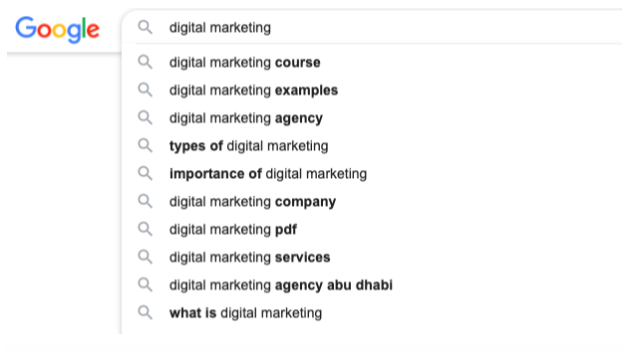
Additionally, scroll to the bottom of the search results page to find “Related Searches.”
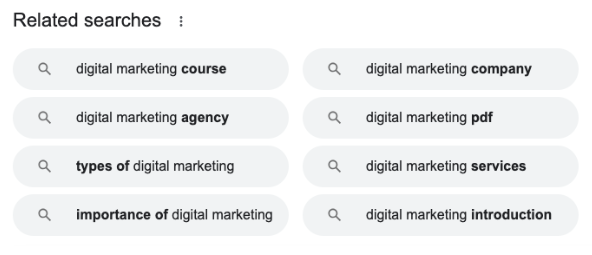
You could also use Google’s People Also Ask section on the search result page to find long-tail keywords. Expand each question to get more and more ideas.
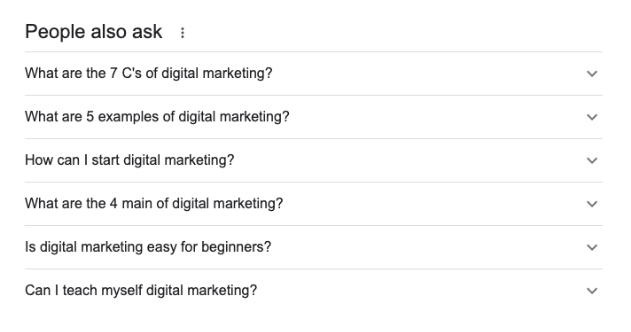
Forum and Q&A Websites
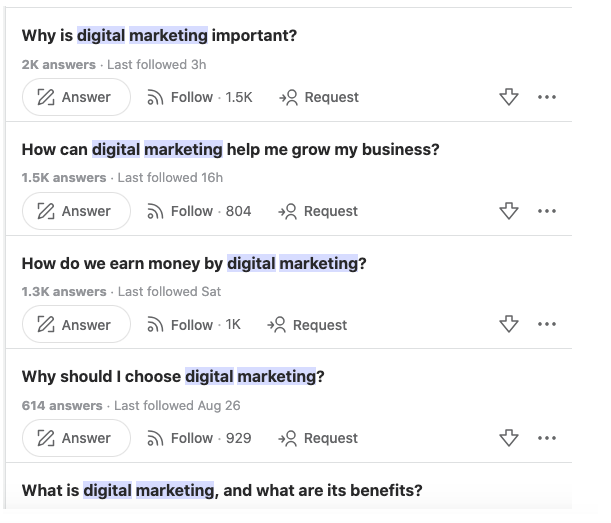
Explore forums like Quora, Reddit, and niche-specific discussion websites. Look for common questions and phrases that users are using. These questions can be excellent sources of long-tail keyword ideas.
Use Keyword Research Tools
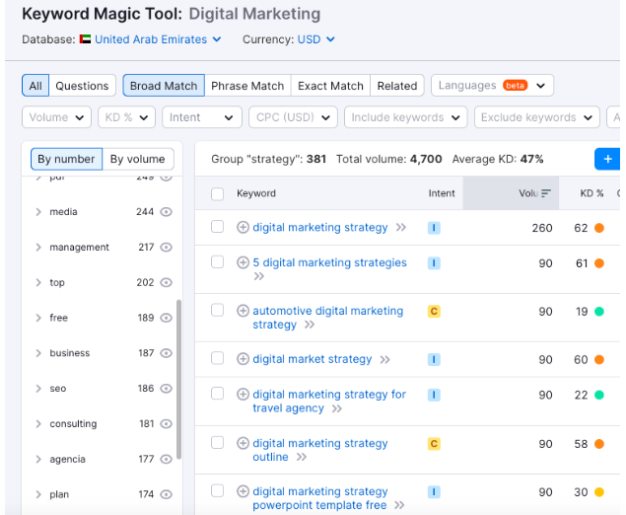
You can use different tools to identify the long-tail keywords. For example, Google keyword planner, Ahrefs, Semrush, AnswerThePublic, etc.
You also get more long-tail keyword ideas from Social Media platforms, Google search console, and Google Trend.
You can also add keyword modifiers such as “best”, “top”, and “how to” or add a geographic location for local business.
How To Use Long-Tail Keywords To Improve Your Website's Ranking?
Once you have found long-tail keywords, you need to use them correctly on your page. Here are some tips on how you can use these long-tail keywords to improve your website’s ranking.
Create High-Quality Content
It’s essential to understand the intent behind the long-tail keywords you’ve chosen. Long-tail keywords can fall into various categories. For example, informational, navigational, commercial, or transactional intent. You must align your content with the user’s intent behind the keyword.
Create content that thoroughly addresses the user’s intent behind the long-tail keyword. Ensure your content is informative, valuable, and well-researched. If the intent is informational, provide detailed information. If it’s transactional intent, then focus on convincing product descriptions or offers.
The image below shows the different stages of the sales funnel and corresponding search intent. Tailor your content to address the needs of users at each stage, from awareness to action.
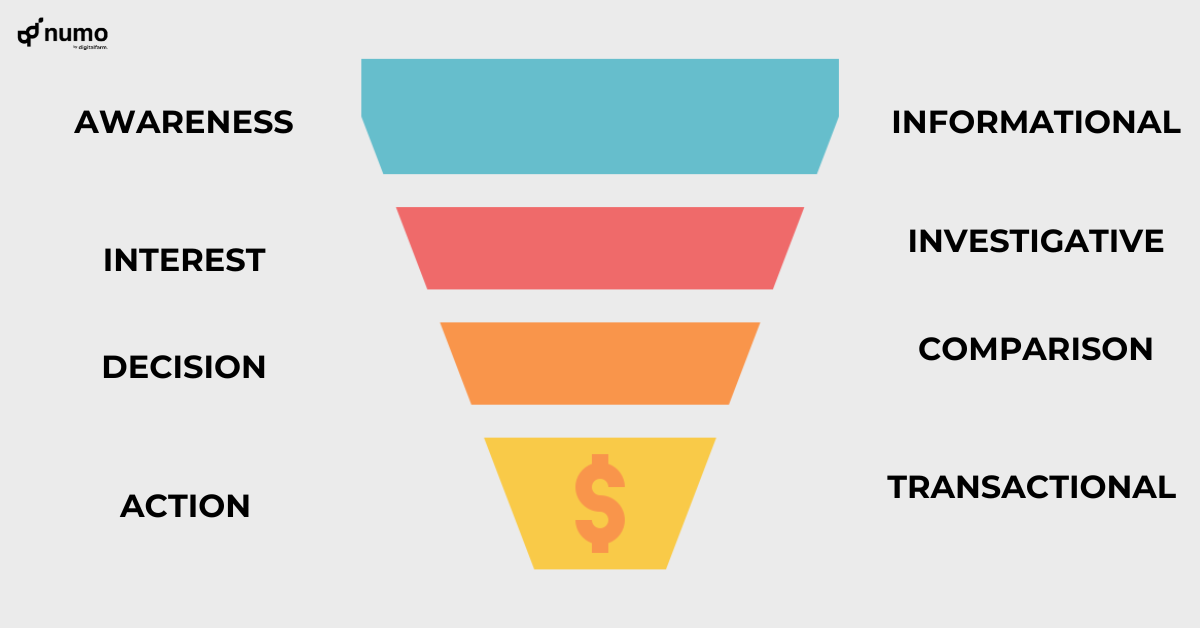
Strategically Place Keywords
Place your long-tail keyword naturally within your content. Here’s where you can use it:
- Title: Include the long-tail keyword in your page’s title, preferably near the beginning.
- Header Tags: Use the keyword in header tags (H1, H2, etc.) to structure your content effectively. This will help to improve readability.
- First Paragraph: Integrate the keyword into the first paragraph or, ideally, the first sentence of your content.
- Throughout Content: Sprinkle the long-tail keyword throughout your content where it fits naturally. Avoid keyword stuffing, as it can harm your SEO and also the readability.
Topic Clustering
Google is getting smarter day by day. It focuses more on Natural Language Processing and a deeper understanding of content. Google BERT algorithm updates help to understand the context of words in searches and better match those queries with helpful results. So to align with these developments in search results, we need to update our SEO strategy. With that said, clustering with long-tail keywords will likely be the most successful approach.
Topic clustering is the best SEO strategy. It involves organizing related pieces of content around a central, or pillar content. Long-tail keywords can be used for creating content clusters.
To implement this strategy, first conduct keyword research to identify relevant long-tail keywords. It should be related to your main topic or pillar content.
Then, create comprehensive pillar content that covers the broader topic and optimize it for a primary keyword.
Next, develop supporting content, each centered around a specific long-tail keyword. Make sure to interlink this content. It will provide a better user experience. It also shows to search engines that your site offers comprehensive information on the topic. This will also help to establish website authority on a particular topic.
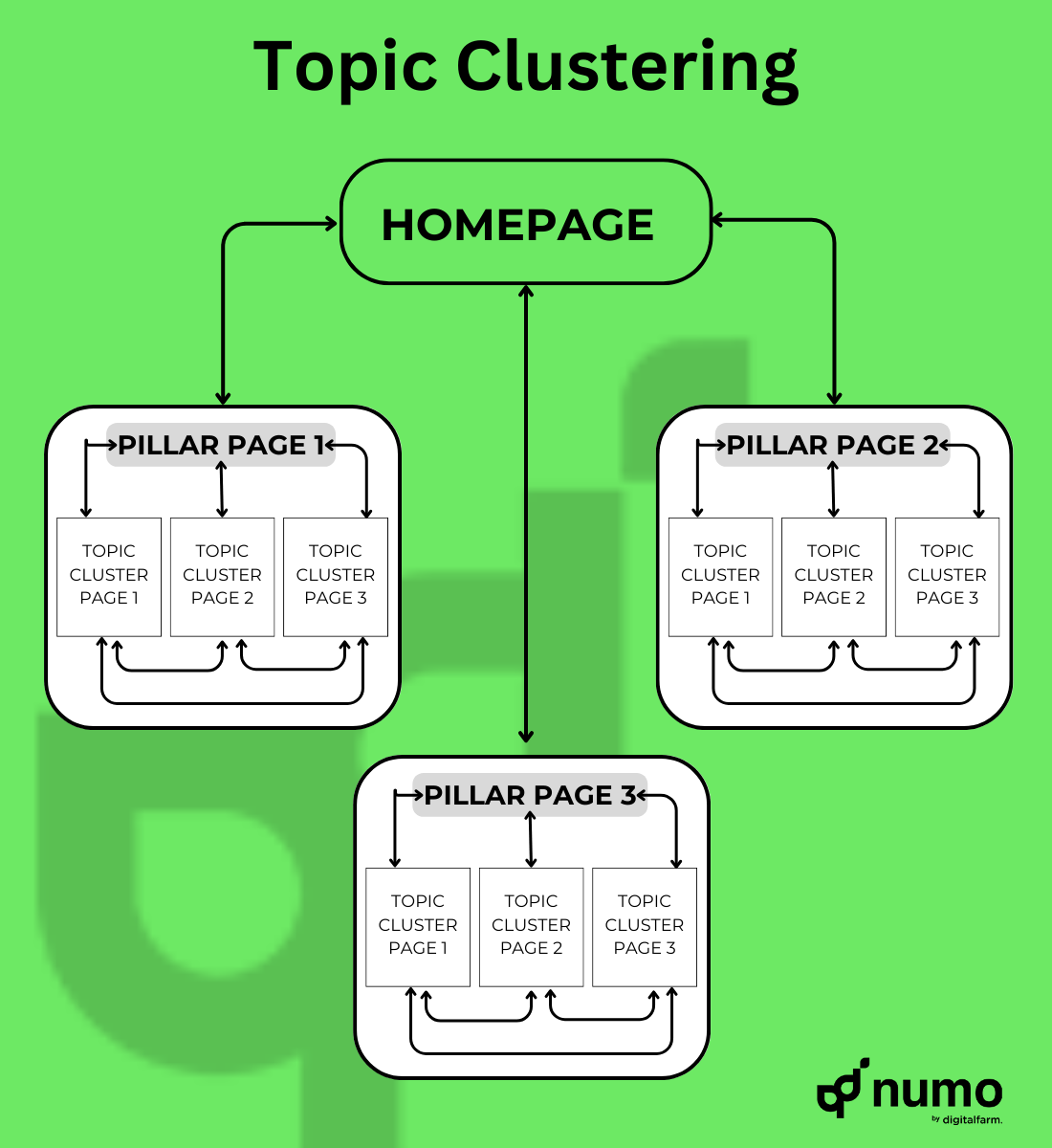
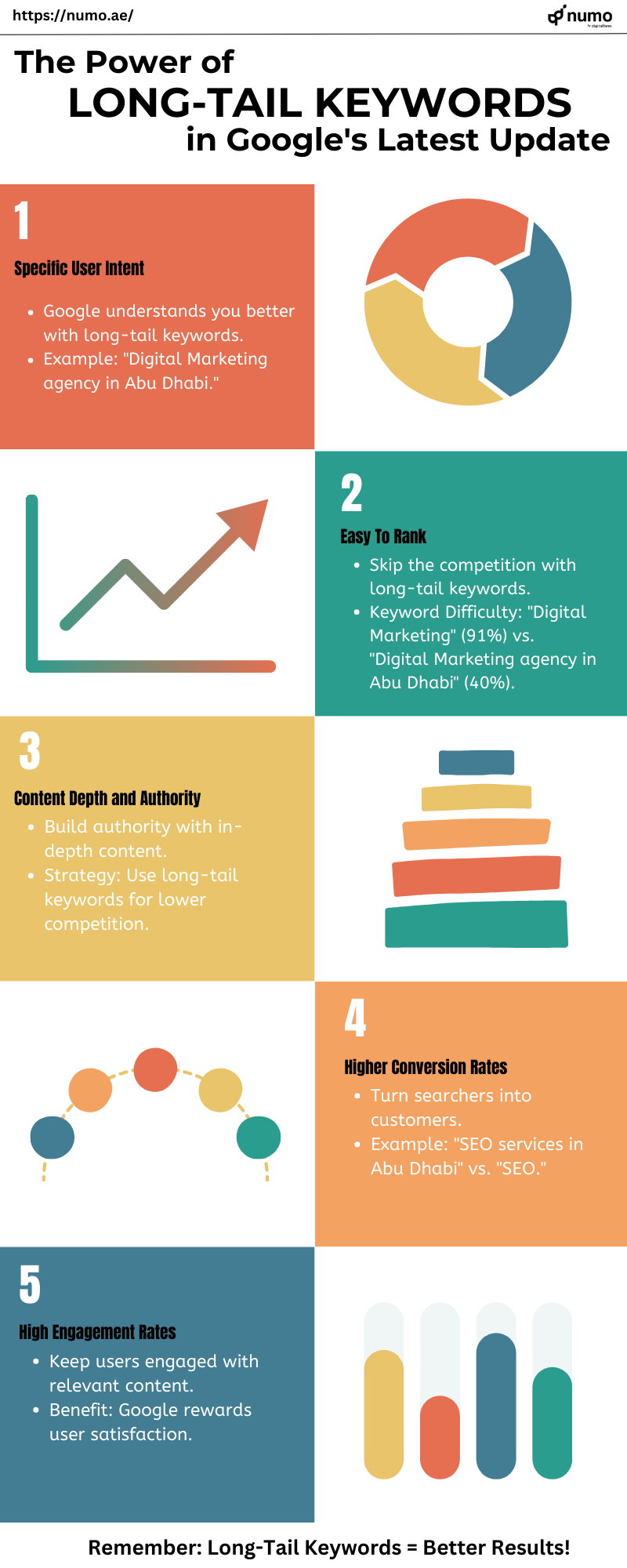
Infographics: The power of long-tail keywords in Google’s latest update.
Final Thoughts
In conclusion, long-tail keywords are more important than ever in the latest Google search update. They align with Google’s focus on user intent and provide a valuable opportunity to improve your website’s ranking, attract a more targeted audience, and enhance the overall user experience. Incorporating long-tail keywords into your SEO strategy can be a powerful way to stay competitive in the evolving world of search engine optimization.
Are you interested in implementing this long-tail keyword strategy on your website to boost traffic? Feel free to get in touch with us! Our digital marketing agency in UAE is here to assist you.

